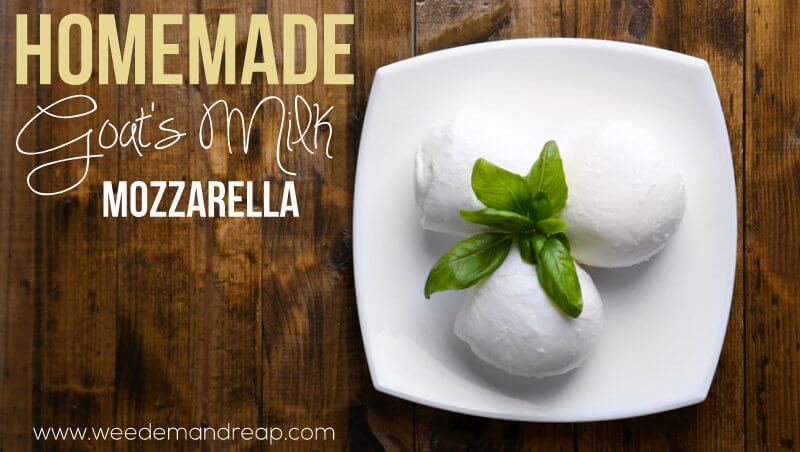 There is really nothing better than homemade mozzarella.
There is really nothing better than homemade mozzarella.
Homemade GOAT’S MILK Mozzarella, that is.
We’ve been chuggin’ the goat milk for about 10 years now. 10 years of bliss. I’m telling you, if you haven’t tried fresh goat’s milk, well then my dearie, you’re missing out. If you come to my house, I’ll pretty much force you to try it. I can’t help it. Visit my farm and I’m probably going to talk your ear off about how amazing goat’s milk is and how it tastes almost identical to cow’s milk. I’ve got into some serious debates about it. Don’t knock it ’till you’ve tried it, yo’.
After you’ve conquered the raising, breeding, & freshly squeezing of goats, the next level is, of course, to make cheese with your bounty. (Read my guide on how to raise & milk goats here.) Cheese is a whole ‘nother level when it comes to making things homemade. It’s not horribly difficult, but it definitely is an art, and just like anything else, your cheese-making skills get better with practice!
There are a lot of homemade mozzarella recipes out there. Some will use cultures, some will use lipase. In my experience, the best mozzarella comes out tasting fantastic when you stick to tried & true recipes. I use a combination of citric acid & thermophilic culture to raise the acidity of the milk and rennet to separate the curds from the whey. You, in theory, could use lemon juice or some other acidic ingredient, but an important part of cheese making — especially goat cheese making — is to get the correct acidity. Too little acidity will make your cheese not stretch in the final steps, and too much acidity turns the curds into a horrible lump of a mess.
Some tips to remember about working with Goat’s Milk:
- Goat’s milk has smaller globules overall, (this is why it’s so much easier to digest) and so when working with goat’s milk, you have to remember to stir slower & be gentler. Stirring too fast and over working your cheese will result in a tougher end product.
- The acidity of goat’s milk can be tricky. Milk at the beginning of a goat’s freshening (right after they have babies) has a higher amount of acidity, then, over the course of the year, it decreases. Keep this in mind when adding citric acid.
A word about those 30 minute mozzarella recipes:
Let me give you a quick translation. 30 minute mozzarella recipe = microwave recipe. What I’ve found is it’s a bit harder to get a consistent result with this. In a pinch it’d be fine, but the standard method I believe works better.
I can get my recipe down to 45 minutes if I have all my supplies ready and I work fast, but a 30 minute mozzarella made the real way just ain’t possible. Stick with the real version. It’s better. Schedule out an hour of your day, turn on an old Doris Day or Henry Fonda movie, and get to it!
Homemade Goat’s Milk Mozzarella Recipe
There are three parts to making mozzarella. The first part involves raising the acidity and temperature. The second part involves “setting” the milk with rennet. The third part involves stretching the curds kind of like taffy and forming it into a mozzarella ball of goodness.
Gathering Your Supplies:
You’ll need:
- 2-3 gallon pot
- large colander
- cheese ladle
- large-sized bowl
- medium-sized bowl
- spoon or spatula to stir
- long knife
- rubber gloves
- some measuring cups & spoons
- cheese salt (cheese salt is salt that is free of additives and doesn’t contain iodine. Iodine will ruin your cheese) – click here to buy
- citric acid – click here to buy
- thermophilic culture – click here to buy
- rennet (not junket rennet) – click here to buy
Before you Begin:
Sterilizing your equipment isn’t completely necessary with mozzarella because it’s not an aged cheese. Still, I like to do it because I like to work in a clean environment and also it gets the pot warm which makes your cheese making process go faster!
To sterilize, simply boil about 2 quarts of water in the pot, and once it comes to a boil, dip all your utensils in. I even sterilize my gloves and turn my bowls over on top to be sterilized by the steam.
Making Goat’s Milk Mozzarella – Part 1:
I like to make mozzarella in 2 gallon batches. Add only 1 gallon to a pot, and then raise the temperature to 86F.
Once it hit’s that temp, add 1/2 packet of direct-set thermophilic culture. Let it re-hydrate for 1 minute before stirring.
Stir, then let sit (covered, with the heat OFF) for 45 minutes.
Next, take your other gallon of milk out of the fridge, add 2 tsp. citric acid diluted in 2 TBS. water to this chilled milk.
Mix well, then add the chilled citric acid milk to the warm milk that’s been cultured with the thermophilic culture.
Bring the temperature back up to 86F
Making Mozzarella – Part 2:
In the second part of making mozzarella, you are ready to add the rennet, which will separate the curds from the whey. Turn off the heat, but leave the pot on the stove. Take a minute to first stop stirring and try to get the milk to stop swirling and to become still. Mix 1/2 tsp. of rennet into 2 TBS. of cool, filtered water. Pour into the milk and stir VERY slowly with an UP & DOWN stirring motion for only 15 seconds, then stop. I can’t stress enough how important this is. The rennet will set up the milk into a solid in about 2 minutes, and if the milk is swirling, it won’t set correctly! So, when you stir, be sure to stir gently up and down for only about 15 seconds, then stop that motion pronto.
Cover the pot with a lid and set a timer for 15 minutes. Don’t touch the milk at all, just let the rennet do its job. After 15 minutes the milk should be “set”. It should have a consistency of a thick yogurt or pudding. Now it’s time to cut the cheese. Take that long knife and slice it into cubes. You can even cut it on an angle as well to get it to cut underneath. After the curds are cut, now it’s time to drain the whey from the curds.
Use your cheese ladle and scoop out all the curds into your colander which should be sitting on top of a bowl. Resist the urge to squeeze the curds or squish more whey out. Just let some whey drip from it naturally, don’t force anything.
Let it drain 15-30 minutes until it becomes a bit tougher like a soft cottage cheese consistency.
Making Mozzarella – Part 3:
Now comes the stretchy part! Stretching the mozzarella is easy and fun! Add to add 1/3 c. of salt to 1 gallon of water and heat that sucker up to 145 degrees. As it’s heating, you can get a medium-sized bowl of ice water ready to cool your mozzarella ball after you’re done stretching it.
Once the pot of water reaches 145 degrees, divide the mozzarella that’s sitting in your collander in two or three sections, throw those gloves on and dip the of mozzarella in the hot water with your cheese ladle. I like to swirl it around, but it’s not necessary. Your goal here is to get the that cheese slab of yours hot and melty! You can cut the curds or crumble it before you place in the water.
Now, the tricky part here is to make sure all of the mozzarella gets hot enough evenly! Too often, the outside of it gets melted before they inside. You can cut it into smaller pieces and stir while they heat evenly, or you can just keep dipping it and testing it with your (gloved) fingers to make sure it’s soft enough inside. I like to lift it up and flip it over a couple times as it gets softer and softer. Your goal is to get it soft enough that you can squeeze all the way through without resistance.
The stretching part is just how you’d imagine. You are stretching and folding, much like taffy is made. As you stretch and pull and fold over, you’ll notice how shiny it gets as the curds change. Once your mozzarella becomes shiny, you can salt it with 1 tsp. of salt, fold a few times, then form into a ball. If your mozzarella has cooled in the end, you can dip it in the hot water again to get a nice smooth ball.
Important Tips:
- It should be so hot that it’s almost too hot to touch, even with gloves.
- It should stretch easily, almost falling out of your hands.
- If you have to pull and tug to get it to stretch, it ISN’T HOT ENOUGH, so keep dipping in the hot water.
After you’ve formed a ball, cool it down in a bowl of ice water for 30 minutes.
Whew, you made your first batch of mozzarella! How do you feel? After your mozzarella has cooled for about 30 minutes, you can wrap it in plastic wrap and store in the fridge for up to 1 week, or you can freeze if for up to 6 months.
Ingredients
- 2 gallons fresh goat's milk
- 1/2 packet direct-set thermophilic culture
- 2 tsp citric acid (non-gmo)
- 2 tsp cheese salt , divided
- 1/2 tsp rennet (not junket rennet) diluted in 1/2 c. cool water
Instructions
-
Sterilize your pot & equipment.
-
Pour 1 gallon of cold milk into the warm pot.
-
Bring temperature up to 86F
-
Add 1/2 packet of direct-set thermophilic culture. Let rehydrate 1 minute before stirring.
-
Stir and let set (covered with heat OFF) for 45 minutes.
-
Take another gallon of chilled milk, and add 2 tsp. citric acid diluted in 2 TBS. water to this. Stir well.
-
Add chilled milk to warmed milk. Bring temp back up to 86F
-
Add 1/2 tsp rennet diluted in 2 TBS. water to the now combined milk.
-
Stir for only 15 seconds in an up & down motion, then stop the stirring.
-
Cover the pot and let it sit for 15 minutes.
-
After 15 minutes, take a long knife and cut the cheese top to bottom and side to side to create cubes.
-
Remove the cheese and place into a colander.
-
While the cheese is draining, add 1/3 c. salt to 1 gallon water and bring to 145 degrees.
-
Divide the cheese in half and dip into the hot water with a cheese ladle.
-
Heat the cheese until it is soft and you can press it with your fingers with no resistance.
-
Once the cheese is hot and soft, stretch it with your (gloved) hands, and fold it over itself, about 10 times.
-
Form into a ball and cool it in ice water for 30 minutes.
-
Wrap in plastic wrap and store in the fridge for up to 1 week and in the freezer for up to 6 months.
 There is really nothing better than homemade mozzarella.
There is really nothing better than homemade mozzarella.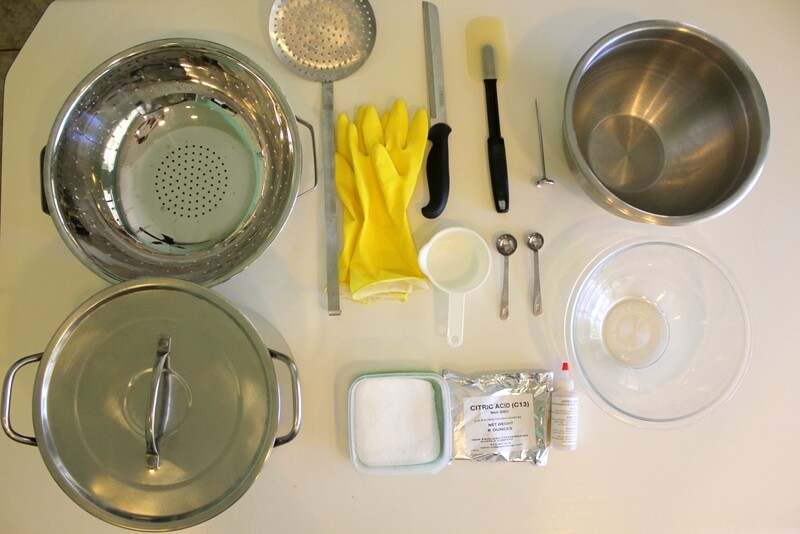
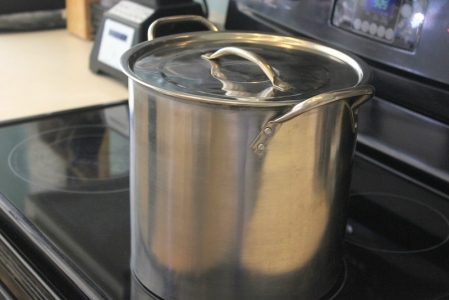
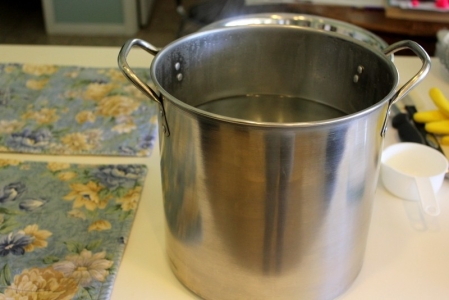
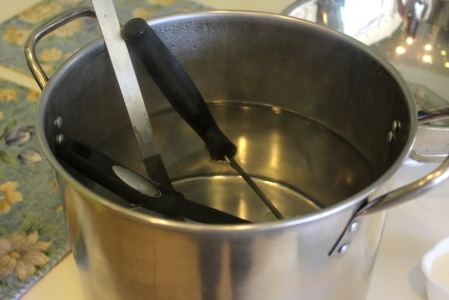
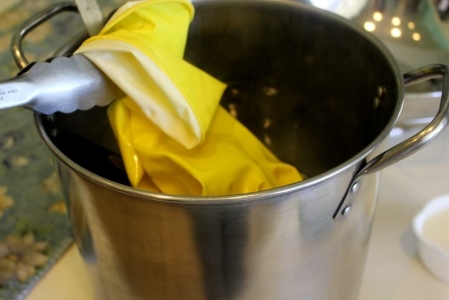
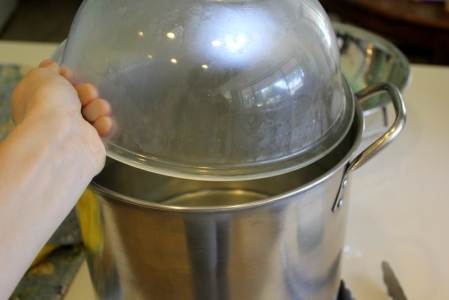
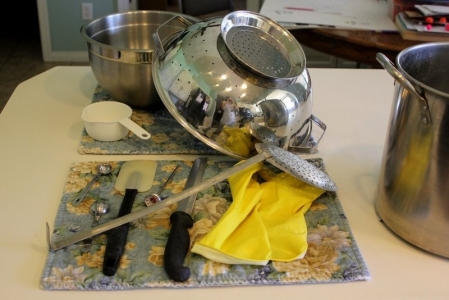
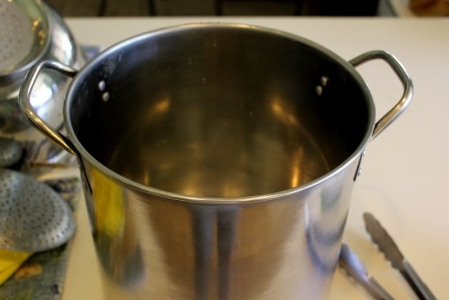
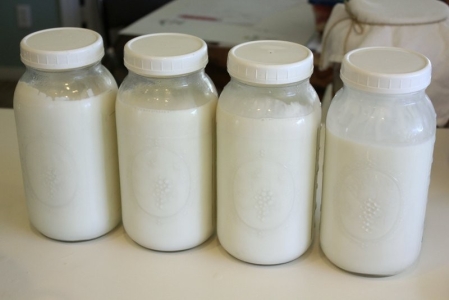
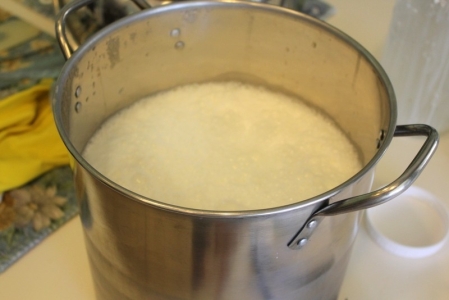
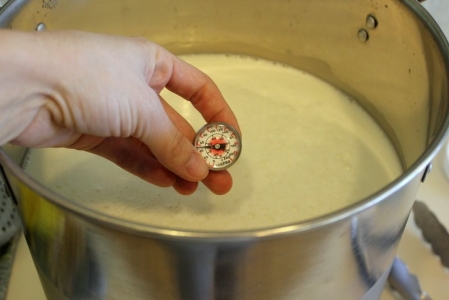
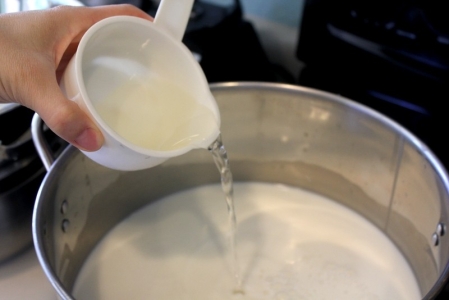
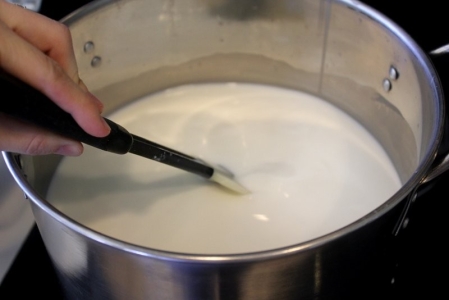
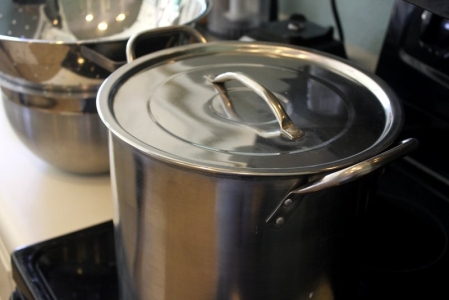
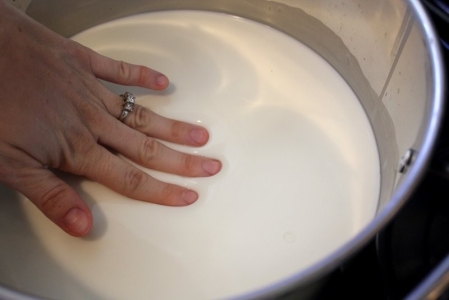
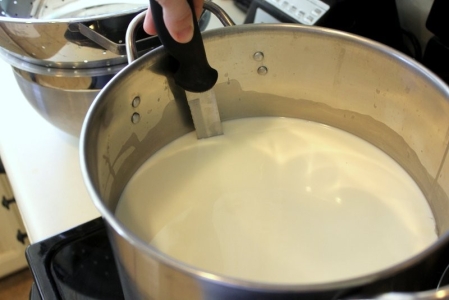
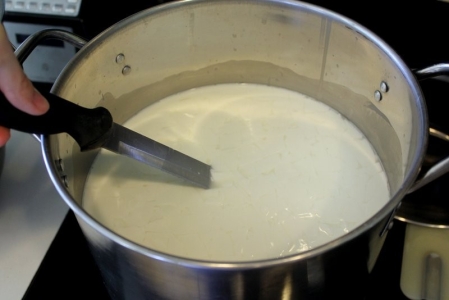
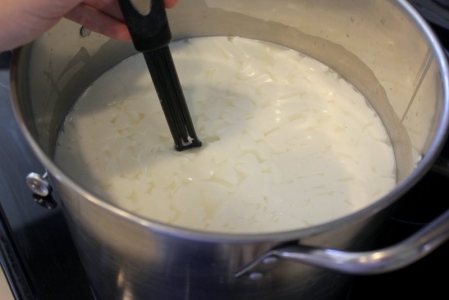
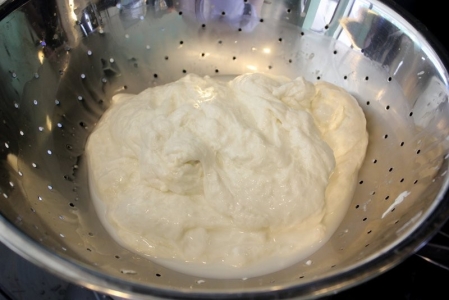
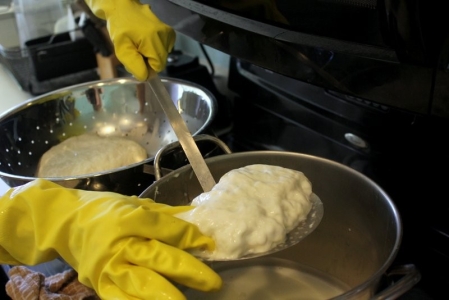
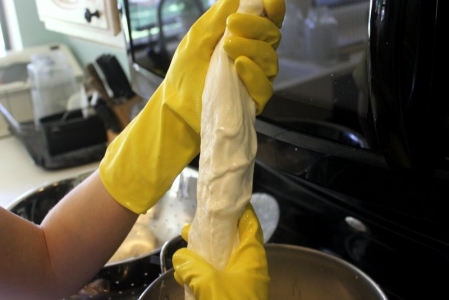
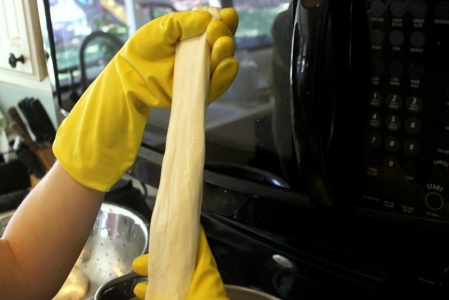
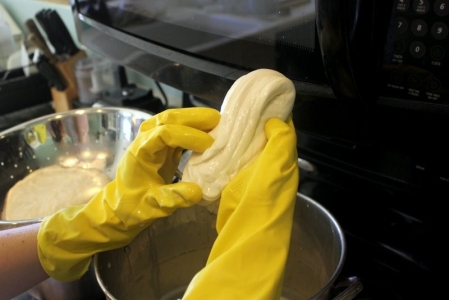
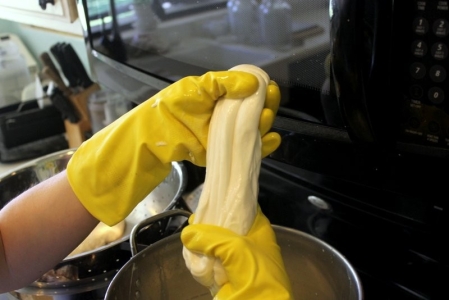
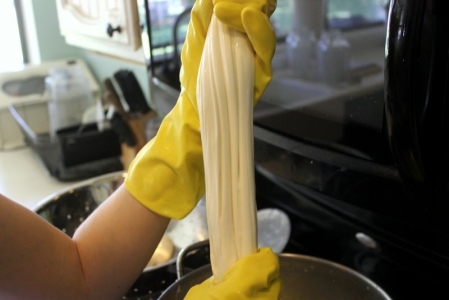
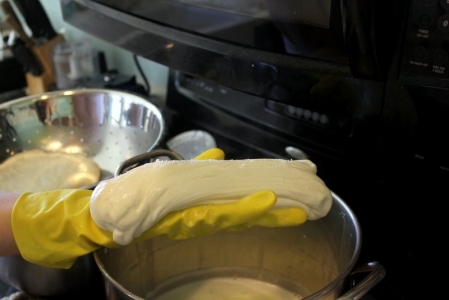
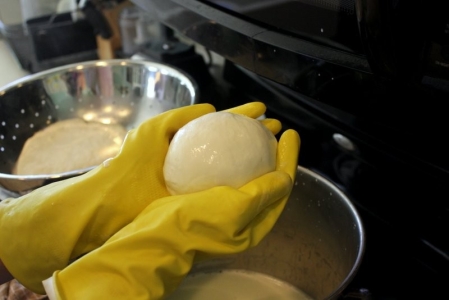
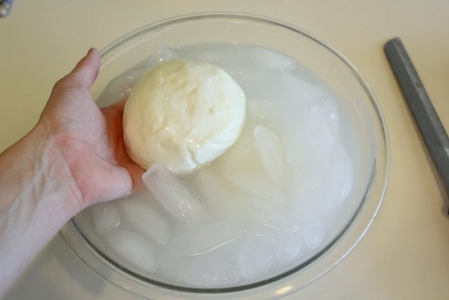

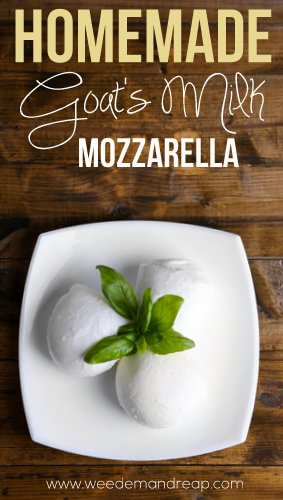
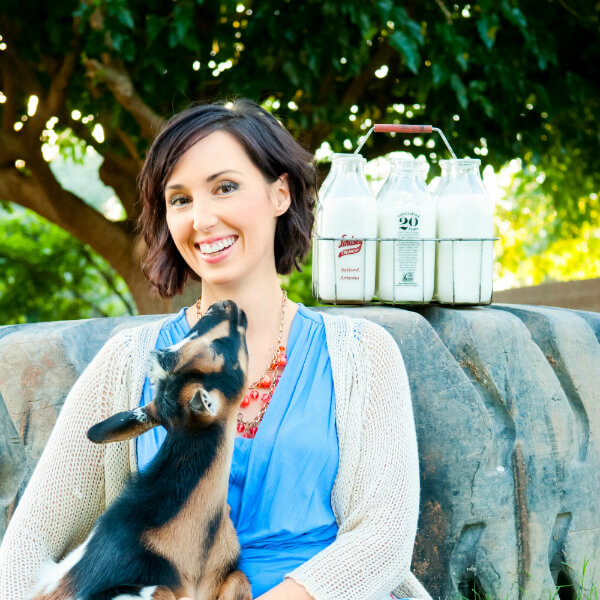
Hi Danelle, thank you for this recipe I’m certainly going to try this one. Do you by chance have a recipe for ricotta mine has failed me. I would really appreciate it. 😉
Thank you Debbie
Hi Deborah-
This is how DaNelle makes ricotta: https://www.allrecipes.com/recipe/254480/easy-and-delicious-homemade-ricotta-cheese/
Just need goat’s milk, lemon juice, and salt.
Thank you -Bobbi (DaNelle’s Assistant)
Thank you kindly for the ricotta recipe. I really appreciate all your recipes can’t wait to try them all. Happy goating friends!
Debbie Rutt
Is there any way to not have to guess with the citric acid amounts with raw goat milk? I want to try your recipe after a couple failed attempts of other recipes. But I think my fails are from the citric acid.
Thanks for a wonderful post.
Hi Amanda-
Use 2 tsp of citric acid and fresh goat’s milk.
Thank you -Bobbi (DaNelle’s Assistant)
I’m confused, am I supposed to dip the cheese into the whey then into hot salt water, or mix the whey and the hot water, or heat the whey with the hot water like a double boiler ?? thanks for the recipe!
Hello Eloi-
The article has been modified and should explain things better.
Thank you -Bobbi (DaNelle’s Assistant)
I finally tried to make this and failed miserably. Since I don’t have access to unlimited goats milk, I bought 2 quarts of Meyenburg milk and adjusted all the quantities accordingly (although measuring out 1/8 package of thermophyllic culture was tricky). It would just not come together. The rennet I bought was fresh and kept in the fridge until use, the culture, kept in freezer. The only thing I can think of is that I may have overheated the milk in the first heat up. I turned it off at 86° but the heat of the pot kept heating it more. So, in a last ditch effort, I added more rennet and let it sit again and nope, nada, nothing.
Was the heating my issue?
Thanks
Hi Brian-
Yes, heating the cheese carefully is critical, as is stirring gently.
There may also be an issue since you are having to measure out the culture.
Thank you -Bobbi (DaNelle’s Assistant)
Hi,
I am really looking forward to trying this recipe to go along with my homemade pizzas.
Reading the instructions and the recipe, the recipe says 3tsp of citric acid, while everywhere in the instructions it says only 2 tsp. So, which one is it 2 or 3 tsp of citric acid?
Since I am simply using store bought goat milk, I don’t have extra to test and try again (although I can buy more I suppose). Will pasteurized, store bought (ultra pasteurized actually) goat milk actually work with this recipe?
Lastly, are packets of thermophilic culture all standard size? I ordered some from Amazon, but it just says “5 packets”.
Thanks.
Brian
Hi Brian-
It is 2 tsp and the recipe has been updated.
The packets are a standard size.
You can use the store bought milk.
Good luck with the recipe!
Thank you -Bobbi (DaNelle’s Assistant)
I thought ultra pasteurized was a no go for cheese-making.
Hi Susan-
It does make a less desirable cheese and a curd that is not well defined.
Thank you -Bobbi (DaNelle’s Assistant)
Will it work to use raw cow’s milk? That’s all that I have right now.
Hi Karen-
Yes, that will work.
Thank you -Bobbi (DaNelle’s Assistant)
hi, i haven’t made the cheese yet but i had some questions if u don’t mind. when u says freshest milk possible , how many days old does that need to be within fir a rough range ( using raw milk from a friend, kidding was quite a while ago, not exactly sure when, don’t know if kids are near weaning but or not)? also what is junket rennet. when i looked it up rennet was in the recipe to make junket, but it just said rennet. i see your preferred in animal rennet. mine says chymosin. does it need to be the animal rennet? also, do i have to things different if i only use a gallon or milk or half a gallon? ( obviously the other measurements decrease?) but is it harder with a smaller amount? i think my friends may only be milking one goat. thanks for answering. i have wanted to do this a long time. i did feta once, and paneer once, but never mozzarella ?
Hi Bonnie-
Fresh milk is just referring to using milk within a day or two of the doe being milked. Has nothing to do with age of the doe or kids.
Junket is a very weak rennet and takes a lot to equal using rennet. Chymosin is a component of rennet (so both are from animals). I find it best to use animal rennet for the best cheese, but you can use either.
You can use less or more milk if changing amounts of all ingredients accordingly, it will be the same.
Best of luck with your cheese making.
Thank you -Bobbi (DaNelle’s Assistant)
I am looking for the recipe I have used for a few years. It is ALMOST this one, even the pictures are the same but the one I printed out does not call for the thermophilic culture, only citric acid and rennet. Did you change your recipe?
Hi Nancy-
The only difference is that with the old recipe you would bring 2 gallons of milk to 55 degrees F and add 2 tsp. citric acid diluted in 2 TBS. water to raise the acidity. However, DaNelle highly recommends doing a thermophilic culture, as it turns out much better.
Thank you -Bobbi (DaNelle’s Assistant)
I’d love to try this. We’ve had goats for years but the mozzarella recipes I’ve tried in the past always turn out rubbery, I’d like to make something like the delicate melt in the mouth buffalo mozzarella I sometimes buy. Is it possible to end up with goats milk mozzarella that has the same delicate texture and soft centre?
Hi Emma-
If the cheese is tough and crumbly, this is usually due to too much acidity or improper heating.
For the heat, be sure to stick strictly with the heat temperatures noted in the recipe.
For the acidity, be sure to measure your citric acid carefully. You can also dilute it in a 1/4 cup water before adding it to your cheese.
Also be sure to use the freshest milk possible, because older milk can be slightly more acidic.
The last thing you can do is be sure to be gentle in your handling of cheese. Rough handling can break up the curds too much, equaling a crumbly and tough cheese.
You can also try to make chevre. It’s much softer: https://www.weedemandreap.com/recipe-chevre-goat-cheese/
Thank you -Bobbi (DaNelle’s Assistant)
I have made this recipe a few times now and it tastes great. I did try to make some queso blanco dip with it and it didn’t melt good. What would cause that?
My kids and I love your channel. I found you while searching for goat births when my 1st goat was expecting over 2 years ago and was hooked.
Hello-
When heat is introduced to this type of cheese, the protein structure falls apart and the emulsion breaks. The fat globules will come together into a greasy pool and the proteins congeal to form a strings. To solve this make half of the cheese you add be American cheese. This will make it smooth.
Thank you -Bobbi (DaNelle’s Assistant)
I’ve tried many times with various recipes to make mozzarella cheese and failed each time. Someone suggested your recipe to me and I tried it today, it came out perfect! So excited to have fresh mozzarella cheese whenever I want!
Wow thank you so much for this! It gives me confidence to try! Just need to find myself a good supply of local goat milk. Can it be pasteurized? Around here, it’s all skimmed down to 3.25% or less – should I try to find something with more fat in it?
Hi Anna-
When the milk is pasteurized it kills the beneficial bacteria, but still make a nice cheese. Lower fat milk is less nutritious and also the cheese doesn’t seem to turn out quite as nice, but it’s ok to use too.
I hope that helps!
Best of luck with your cheese making!
Thank you -Bobbi (DaNelle’s Assistant)
Is there a reason that you say not to use Junket rennet?
Hi Becca-
Junket rennet doesn’t work for this recipe, because unfortunately, it doesn’t have the proper strength.
Thank you -Bobbi (DaNelle’s Assistant)
This recipe makes a tough cheese! I should have quit when instructed to ‘cut the cheese,’ from yogurt or pudding type curds.
Hey, I’ve tried your recipe a couple times now but the cheese ends up super tough. And I have a hard time stretching it because it just rips apart. And before I start stretching I have to mash the curds together because their too crumbly. I love cheese especially mozzarella. Please help!!!
Hi Victoria-
If the cheese is falling apart or is tough and crumbly, this is usually due to too much acidity or improper heating.
For the heat, be sure to stick strictly with the heat temperatures noted in the recipe.
For the acidity, be sure to measure your citric acid carefully. You can also dilute it in a 1/4 cup water before adding it to your cheese.
Also be sure to use the freshest milk possible, because older milk can be slightly more acidic.
The last thing you can do is be sure to be gentle in your handling of cheese. Rough handling can break up the curds too much, equally a crumbly and tough cheese.
I hope this helps and your next batch of cheese turns out great! Best of luck!
Thank you -Bobbi (DaNelle’s Assistant)
I tried it again, but this time I cut the citric acid by a third. Now when I was trying to stretch it, it was really falling apart. Like ricotta or cottage cheese. I did mess up with the temperatures so it’s crumbly and rubbery. Is there a specific size you want to cut the curds to? And could heating it too quickly be part of the problem?
And do you guys have a video on making cheese? That could be helpful.
You may want to try dissolving the citric acid in 1 1/2 cups of lukewarm water before adding it to the milk. And yes, heating too high and too quickly can mess up your cheese. It doesn’t matter what size you cut the curds, but do be extremely gently when stirring your curds. I’m sorry there isn’t a video to share. Thank you -Bobbi
Hi thanks for the recipe! I’m just wondering about all that milky stuff that comes out when your stretching the cheese. Is it something like the more you leave in the smoother your cheese will be and if you squeeze it all out the tougher it will be? Thanks
Hi Katherine-
That is the whey, and no it does not make it smoother.
Thank you -Bobbi (DaNelle’s Assistant)
So encouraging! Mozzarella is not so easy to make as i was led to believe & mine has failed over & over. Can’t wait to try your microwave-free recipe. Love your videos!
So encouraging! Mozzarella is not so easy to make as i was led to believe & mine has failed over & over. Can’t wait to try your microwave-free recipe. Love your videos!
It worked! Need to figure out salting a little better.
This one was even better. It actually stretched…a Lot! Maybe I can really do this!!
THANK you so much for this easy to follow recipe.. IT GIVES an entire new love of cheese! I just started milking my Nigerian goats and tried this and LOVE IT!! LOVE your blog and family and Youtube.. Learned tons from watching.. Bless you for sharing to help others..
Hi DaNelle, just wanted to say thank you for posting this well thought out recipe. I’ve been making moz with our goat’s milk for a few years now using a recipe in “A Cheesemaker’s Journey” but recently had a spill that destroyed the book. After finding your recipe and making it your way I’m not so sad 🙂 I love how you break it down and make it simple. The cheese turned out so good too! Good to know that milking cycle effects the acidity. Nice work!
I tried to make the cheese and it fell apart while stretching. The ones that didn’t as bad was the one i forgot to add the salt to. I was using non ionized salt. Any suggestions? I was also wonering if the recipie called for citric powder or crystals-. I used powder. Could this cause it to fall apart stretch?
Hi Jen-
If the cheese is falling apart or is crumbly, this is usually due to too much acidity. Be sure to measure your citric acid carefully. You can also dilute it in a 1/4 cup water before adding it to your cheese. When using the crystals, you may even want to reduce the amount of the citric acid by a 1/2 or 1 teaspoon (using just 2.5 or 2 teaspoons).
As for using citric acid powder vs. crystals there is a difference. You can use either one in this recipe (as long as they are both food grade) but do know that the powder is finer and you will need to use less. So when using the powder I would cut the amount in half and see how that works for you.
Also be sure to use the freshest milk possible, because older milk can be slightly more acidic.
The last thing you can do is be sure to be gentle in your handling of cheese. Rough handling can break up the curds too much, equally a crumbly cheese.
I hope this information helps and your next batch of cheese turns out great! Let us know how it goes. Best of luck and Happy Cheese Making! -Bobbi (DaNelle’s Assistant)
Hi, I have tried this recipe twice and can’t get the curds to seperate properly. I think it could be because of the milk purchased, so I will try again once I have raw goat milk to work with. Basically I follow everything exactly and my 1st attempt it seemed to seperate ok but it dissolved when I tried stretching. The 2nd time (today) it did not clump into curds after letting it set after the rennet step.
So both times I ended up with a tasty cheese spread similar to ricotta but not mozzerella.
Hi Katie-
So glad you are trying the recipe, but I am sorry it’s not working out as planned. Although the cheese spread sounds lovely!
With the cheese dissolving, the acidity might be your problem, and yes that depends on how fresh your milk is and the amount of citric acid you use. So play around with that. Also make sure your cheese is heated enough prior to stretching.
As for it not setting up, this can be from the stirring. Be sure to always pour and stir everything extremely slowly. Look at the advice DaNelle gives in the recipe under “Making Mozzarella – Part 2:”. Hopefully this will help. Thanks for reading and trying the recipe! Best of Luck and let us know how it went. Happy Cheesemaking! -Bobbi (DaNelle’s Assistant)
I have a question about the step involving salting the whey to use to heat the cheese. Does this preclude using that whey to make ricotta later? If I wanted to save the whey to use unsalted, can I just heat up some salted water instead?
Hi Minyassa-
You can use the whey to make ricotta later, although I have had some trouble with the ricotta setting up and it seems the end result of the ricotta is saltier than I like. You can definitely use salted water instead of whey, which is what I do so I can save my whey for either ricotta making or to feed my chickens or pour around my garden. So I would say use the salted water and save your whey to use unsalted.
I hope this helps. Good luck on your cheese making! -Bobbi (DaNelle’s Assistant)
Wow! Totally daring to make your own cheese. This is something I have been wanting to do for awhile and I have seen the rennet tablets on the shelf in the canning section at the store but have just not taken the plunge. Thanks for the recipe and tips!
Hi Sarah-
That’s great you are going to try making cheese ?! Best of luck! -Bobbi
Hi From Far Northern California,
I has to let you know…I have tried about 20 various recipes for Motz over the past couple of weeks. And yes, god forbid, even the dreaded microwave version. None of these were very convincing Motzarellas–tasty, but bland, rubebery.
Your recipe, however, was very easy to follow, with clear directions and clear pictures along side to illustrate. Two gallons of goat’s milk, and I think I got at least a pound and a half of cheese. Your recipe came together perfectly. forming a nice glossy ball.
If there were one critique that I might modify or change would be the amount of salt at the end. I think I will try backing off a bit (3/4 and 1/2 tsp) and probably will try a few different salts (Hawaiian Black and maybe Himilayan Pink)
One again, thank you for setting me off on this cheese making journey!
I’m so glad it worked well for you!
Hello, I tried this recipe today and it was way to follow and mad enough a great cheese. This was my first time. My mozzarella can even out a bit hard and chewy. What is this from? Thank you
I have tried this recipe several times. My problem every time is my cheese is always crumbly in the stretching phase. What am I doing wrong?
Hi Fancy-
I am sorry to hear you are having trouble with your cheese. If it is coming out crumbly, this is usually due to too much acidity. Be sure to measure your citric acid carefully. You can also dilute it in a 1/4 cup water before adding it to your cheese. You may even want to reduce the amount of the citric acid by a 1/2 or 1 teaspoon (using just 2.5 or 2 teaspoons).
Also be sure to use the freshest milk possibly, because older milk can be slightly more acidic.
The last thing you can do is be sure to be gentle in your handling of cheese. Rough handling can break up the curds too much, equally a crumbly cheese.
I hope this information helps and your next batch of cheese turns out great! Let us know how it goes. Thank you for reading and posting. Best of luck and Happy Cheese making! -Bobbi (DaNelle’s Assistant)
Hello there! Thank you so much for your blog. It has been a life saver since getting goats! I have a question. This recipe was my third attempt at making goats milk mozzarella and I can never get it to stretch. Your recipe was the closest I’ve gotten but still no solid stretching yet. I have read conflicting things about stretching that says too much or too little PH. I am going to keep going until I master it but can you give me your opinion on whether or not next time I should use more or less citric acid? My girls are 3 mos fresh. Thanks!
I’ve used the recipe a couple times now but the cheese is always kinda bland, even when I add extra salt. I’m wondering if I can add seasonings such as garlic and herbs to the milk before making the cheese or will that make it not turn out right?
Hi Sarah,
Yes, mozzarella is a more bland cheese, but you can definitely add herbs!
LaDelle –
Thanks for putting all this down on screen. I’m eager to try it. I have some questions though.
When cutting, how does one cut the cheese side to side in a stock pot? I’m assuming it is from side to side.
And how big should the cut curds be?
Thanks again,
Keith
I don’t want to waste any milk, do you happen to know what the PH should be so I can test it while I’m adding the citric acid? If not what time of the milk cycle is this recipe based on? Both of my goats were freshened in the spring and it’s currently December.
I’m so excited to try making mozzarella with goat milk. We just got our goats (a La Mancha and an Alpine). I’ve done fairly well making cow mozzarella but occsionally I’ve had minor problems and your instructions give really great tips that I think will help me avoid those mistakes (at least a little more). ?
Hi Dani,
I don’t have the specifics on what the pH would be, but I would say expect to mess up with your mozzarella a few times:) The good news is you can shred most mozzarella no matter how it turns out:) Good luck!
Thank you for all your time you put in to helping others! This is our second time making cheese. The first was not so cheese looking. I got a thermometer and used this recipe, and we did well! Thank you.
I tried the 30-minute mozzerella and failed, miserably. We needed cheese for dinner so my husband said to try again. I found your recipe. OMG! It worked so much better. I do have a question though. It seems light in flavor. Is there anything that can be done to give it a stronger flavor or is it just my goats milk?
YAY!! I’m so glad it worked!! Mozzarella doesn’t have a particularly strong flavor, but the higher fat content, the better it’ll taste:) Goats have higher fat content at the beginning of their freshening (about 2-4 weeks after having babies)
What is rennet
Rennet is what thickens milk solids into cheese:)
My 10+ previous tries turned out……not mentionable. Today with this recipe I was successful!! Eggplant parm tomorrow!! Thank you!!!
WOOHOO! This makes me so happy! Congrats, Lisa!
Nice recipe, if I can get my hands on some quality goats milk I’ll definitely give it a go.
I just feel that I need to mention that you are persisting the urban legend that microwaves irradiate the food with nuclear radiation, making the food harmful.
This is not the case.
Microwaves utilize radiowaves that make the water molecules inside whatever you’re cooking vibrate, and that vibration in turn creates heat.
Using a microwave is in fact, bar none, the most effective way to steam vegetables, both regarding time efficiency and retention of many important minerals and vitamins since the cooking process is so fast and relatively low temp compared to other methods.
Will vegetable rennet work too?
Yep!
I have tried mozzarella several times and got rubber. I have asked a cheese tech for help and he just said goat mozzarella is difficult. I am so excited to try your recipe. I get about 2 gallons of milk a day and yet I buy mozzarella. THAT is going to change!
Hmmm, that’s not correct goat’s milk mozzarella isn’t any more difficult than cow’s milk. If it is rubber I would say you stretched it too much. Don’t stretch it so much and be more gentle and see what happens:)
Does the pot need to be stainless steel or can I use aluminum? Why not use junket rennet?
Hi Annalee,
Junket rennet won’t work for this recipe, unfortunately, it doesn’t have the proper strength. You can use aluminum, but we tend to use stainless steel for everything here:) You’ll see a call for stainless steel pots when making cheeses because it cleans & sterilizes better.
Thank you!!! I’ve been making cheese for about 6 years now and even ran a cheese herd share, making a different cheese (everything from chevre to Bloomy rinds) each week for over 50 families for 2 years, so I consider myself a decent cheesemaker, yet I have never ever been able to get a great mozz – even using a pH meter – until trying your recipe on a whim today. I did a little happy dance when I saw how perfect the curd looked before stretching!
WOOHOO! This makes my day! Cheese is such an art, but I’m glad to at least have mozzarella down!
Thanks for the recipe, I can’t wait to try! Can I halve the recipe with the same results? It would take me probably a week or more to get 2 gallons of milk from my goats.
Yes, you can totally halve it:)
I halved mine and it came out perfect 🙂
Love your website and you are doing an amazing job with it. I found it a few weeks ago while doing a search on goat raising and I couldn’t stop reading your various posts. I am a busy mom of four and can’t spend the time going through all of the comments. So my apologies in advance if this question has been answered above. before I embark on goat raising myself, I want to try the milk. I’ve seen it sold in half gallons in Walmart…is this an ok place to purchase my first batch of goats milk to test or should i find a local farmer who might give me a taste?
Hi Stephanie!
Definitely a local farmer, the milk will taste much closer to what yours will be like.
Is the temperature in Celsius or Fahrenheit? thank you!
Fahrenheit 🙂
Ive been skimming your blog for years waiting to have goats. I finally got my milking goats two months ago and used this recipe today! Two perfectly done batches of cheese later I am one happy momma!! Thank you!
Thank you, thank you, thank you!! Finally a recipe for mozarella that works. I cannot tell you how many times I tried (and failed). One failure was so hard and rubbery I considered applying for a patent for car tires. Ha! Amazing results with your recipe on the very first try.
This was amazing! My first try making cheese and your instructions were so awesome. The only problem with this recipe is , I can’t keep the cheese around long enough! Thank you so very much , this first time cheese maker appreciates the effort it takes for you to share your expertise with us. Now that I’m reading further comments, I’m kicking myself for dumping the whey. I thought it would be too salty to use. Darn!
I understand the salt must not have any iodine or additives, but would 100% sea salt or 100% himalayan salt work? Also, I don’t live near a farmer with a goat. What kind of goat milk should I purchase in the store to use in this recipe? I’m really excited to try making this soon!
Hi Linda,
Himalayan & sea salt don’t absorb as well, I’ve tried it:)
I can’t wait to try this. I have sooooo much milk from my 2 does. I make Finnish squeeky cheese but I have so much in the freezer. Now I will have another cheese to try. Thank you!!
I love squeaky cheese but have on made mozzarella, chavre and yogurt so far. Do you have a recipe you would share for the squeaky cheese?
Can I use Meyenberg whole powdered goat’s milk?
Hi Sharon, no you can’t:( It won’t work in the same way because the proteins have been changed.
Hello! I just found your website and am loving the info., especially this one on making goat mozzarella cheese! My husband and I just got two Nigerian dwarfs..a momma and her kid and love the milk! I will be trying this recipe soon! Thank you for great information!
Hello! Thank you for the wonderful pictorials here. Can liquid rennet be used here? What would the measure be? My husband has some leftover from past (unsuccessful) cheesemaking pursuits and I’d love to be able to use his if I can!
Also, I’ve often seen with Italian mozzarella that they store the balls of cheese in the whey, or in a salted brine until using. How do you feel about that?
Yes, I use liquid rennet in this recipe:) Also, you can store in a brine, definitely!
Tried this last night with milk from one of our local goat farms (Dirty Girl…love it!) and it came out FANTASTIC! My husband was astonished. It was creamy, silky, just firm enough to have it’s own shape but milky and wonderful in the middle. Some of the best I’ve had, and I am pretty sure I screwed up a step in there. Thank you for this tutorial! I am one more step closer to winning him over in the “Can’t we PLEASE have a goat!” debate.
Yay! Congrats! It’s a big feat to make some good mozzarella!
🙂
Please help I have tried over and over again to make this. I do just fine until step 3 because my cheese turns out grainy and just falls apart so there is no pulling because it doesn’t stay together. Do you have any advise. Thanks
Grainy cheese means you added too much citric acid. I would cut the citric acid in half and see what happens! Some goats can produce too much citric acid in their milk, especially toward the end of their milking season:)
This looks great! Where do you get your goats milk from? Store? Farmer? Thanks for the great post!
Thank you! This is what I was looking for, a mozzarella recipe that doesn’t use a microwave. Bonus for me, it’s with goat’s milk!
Yay! So glad I could help!
I also wanted to know if there is something you can do with the left over whey?
Yes! My friend Jill has some great tips https://www.theprairiehomestead.com/2011/06/16-ways-to-use-your-whey.html
This looks great but I don’t know where to get goat milk; I’ve occasionally seen it in cans but that would be pasteurized. Any ideas? Also, what do you do with the leftover whey?
Hey Kim, here are some great uses for whey –> https://www.theprairiehomestead.com/2011/06/16-ways-to-use-your-whey.html
Hi there! Thanks for the post. Do you have any experience with vegetable rennet and/or do you know if it would work? I am also wondering what the cheese yield is for this recipe. Thanks!
Yes, vegetable rennet would work as well — same measurements:)
how much cheese does this recipe make?
Makes 1 pound of cheese.
Hi, I have made this with my goats milk and while the cheese turns out great the colander is a cheesy mess afterwards. The cheese while waiting for the whey to heat to 175 oozes through the hole in the colander. Do I need a special colander or do you have any tips for me to prevent this? For clean up I have to pour tons of boiling water over the colander to melt it off.
I grew up making cheese on a dairy farm in the 1960s, we always line our colanders with wet cheese cloth, at least 2 layers. This always allows for easier clean up. make sure it is soaking wet, or the cheese will stick to it.
Hey, thanks for the post. I’ve tried cheesemaking several times but these have been the best instructions so far. I tried to make it and it turned into a lovely stretchy goodness, only the next day it was bitter… why would it turn bitter?
Hmmm, it could be that you added too much citric acid in the beginning. It should stay good for up to 10 days in the fridge. Was it solid or more soft?
OK, I added just as much as the recipe stated but maybe the milk’s PH level was different…it was soft.
I would say that maybe you’re whey wasn’t hot enough when you did the stretching. It needs to be hot enough to get the mozzarella hot fast. Also, be sure to cool it down afterwards in ice water. These two things should make it tougher.
Can I use raw cow’s milk instead … Thanks for sharing!
Yep! You can!
So excited about making this once the weather cools a it in Florida! Great visual instructions.
I was wondering the same thing.
I don’t have access to goat milk. Can this be made with regular milk? If so, Whole, 2%, Skim? Thanks!
Yes, but it can’t be ultra-pasteurized milk.
I love mozzarella cheese and have always wanted to make my own. You make it look so easy. And nothing beats the taste fresh goat milk. Can’t wait to try this!
Wow, DaNelle this looks delicious! I can’t wait to try it with some of my grandmothers goat milk. One question, can I use regular salt???
“cheese salt (cheese salt is salt that is free of additives and doesn’t contain iodine. Iodine will ruin your cheese) ” From the article above.